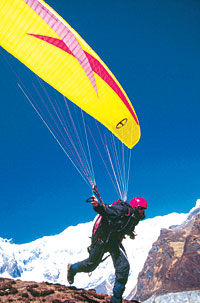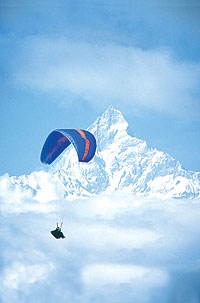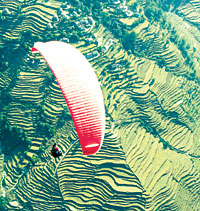 Imagine a Himalayan griffon vulture riding the catabatic winds over Sarangkot. The air roaring against her ear, soaring on the mid-morning thermals, higher and higher until Phewa Lake is like a little green jewel, Machhapuchhre and the Annapurnas etched against an azure sky. Now imagine that griffon vulture is you.
Imagine a Himalayan griffon vulture riding the catabatic winds over Sarangkot. The air roaring against her ear, soaring on the mid-morning thermals, higher and higher until Phewa Lake is like a little green jewel, Machhapuchhre and the Annapurnas etched against an azure sky. Now imagine that griffon vulture is you. That is what it is like to go paragliding in Pokhara. Nepal's latest adventure tourism activity. Get up there to look at central Nepal and the Annapurnas from the vantage point of the gods.
Paragliding is the sport of flying-yes, flying-using a specially designed parachute. It is the best way to experience all the wonders of Nepal-lakes, mountains, natural splendour and for some, even nirvana. Note: paragliding is different from the ultra-lights that you hear whirring above Pokhara every morning that offer an hour-long sight-seeing flight in small motorised gliders.
Few guidebooks urge us to go ahead and soar right into the crisp, fresh air of the mountains. That is a shame, because paragliding and Pokhara go together like tomatoes and timur, strawberries and swirly whipped cream. Now, finally, there is hope for those of us in Pokhara who want some activity, but cannot afford the time to go on a trek. No more is renting a boat (yawn) and paddling listlessly across Phewa Tal (snore) the only option. Now there is a chance to get one of the biggest highs of them all-getting up close and personal with that great inverted forked fish-tail of Machhapuchhre.
 Sunrise Paragliding, the first Nepali company to start commercial paragliding, has been in business in Pokhara since 1999. Since then more than 1,000 people have been airborne in the skies above Pokhara, and got a little bit closer to the mountains. In order to promote the activity, which has huge adventure sport cache overseas, the company has also been organising "international level" championships. In the third paragliding championship held here in December, there were 16 contestants from ten different nations. Participants were required to take off from Sarangkot, fly above Torepani and land at a designated spot on Lakeside. They were judged on the varying levels of skills they exhibited in the air. Although there were fewer participants in 2001 as compared with the previous year, when there were close to 40 competitors, enthusiasm was high.
Sunrise Paragliding, the first Nepali company to start commercial paragliding, has been in business in Pokhara since 1999. Since then more than 1,000 people have been airborne in the skies above Pokhara, and got a little bit closer to the mountains. In order to promote the activity, which has huge adventure sport cache overseas, the company has also been organising "international level" championships. In the third paragliding championship held here in December, there were 16 contestants from ten different nations. Participants were required to take off from Sarangkot, fly above Torepani and land at a designated spot on Lakeside. They were judged on the varying levels of skills they exhibited in the air. Although there were fewer participants in 2001 as compared with the previous year, when there were close to 40 competitors, enthusiasm was high. The highlight of the event was when Nepali participant Rajesh Bomjom won the solo flight event. Rajesh, the first Nepali to receive a paragliding license from London, works for Sunrise Paragliding. Says the high flier: "It hasn't been long since I started flying, but the feeling is inimitable-once you're off, it feels as though you have wings. Jump off from Sarangkot and kiss the beauty of the Himalaya and the lakes, and you wish you could fly forever." Many competitors had pretty adventurous plans, including flying over Syangja, Palpa, Parbat, Kaski and the Annapurna Conservation Area, but these had to be cancelled due to bad weather. Despite that, some competitors showed off some pretty hair-raising tricks-even landing on the waters of Phewa Tal with their girlfriends making up the second flier that the chutes can carry.
 Nepal's terrain and weather make it an ideal paragliding country, especially from mid-autumn to end-winter. You're best off flying between late morning and late afternoon, when the wind speed at this time of year is just right to soar like an eagle. Indeed, that is exactly who you fly with-paragliding is considered best and safest in the warm spaces favoured by high-flying birds such as eagles. Quality flying needs fair wind, too much of it, or rain, is an obstruction.
Nepal's terrain and weather make it an ideal paragliding country, especially from mid-autumn to end-winter. You're best off flying between late morning and late afternoon, when the wind speed at this time of year is just right to soar like an eagle. Indeed, that is exactly who you fly with-paragliding is considered best and safest in the warm spaces favoured by high-flying birds such as eagles. Quality flying needs fair wind, too much of it, or rain, is an obstruction. As with anything to do with flying in Nepal, the bureaucracy has to get involved. And under our 1994 Civil Aviation Policy, the Civil Aviation Authority has approved commercial paragliding taking off from the Torepani cliff in Sarangkot, over Lakeside, the Mahendra caves, Phewa Phaant, and landing at Naudada. Still, paragliders have to be on the lookout for the morning Pokhara-Jomsom shuttles and get used to the Twin Otters and Dorniers droning beneath their feet.
It is strange that although Nepal is promoted so often as an adventure sport destination, the opportunity to fly the majestic skies is such a recent one. Late it may be, but at least it diversifies a tourist market that is getting just that little bid jaded, not to mention having to cope with all the craziness of the last year. Commenting on how the sport has brought about more variety
in tourism to Pokhara, Biru Bomjom, director of Sunrise Paragliding says with conviction: "We need to be innovative and creative if we are to take Nepal's tourism industry forward. We think paragliding as an adventure sport can help in this."
Bomjom started the business with paragliding chutes that each cost about Rs 200,000. It is a big investment, and of course safety is an issue, so, until there are more skilled pilots in Nepal, Bomjom has had to hire foreign pilots. And as there aren't any training facilities or schools, Bomjom has been providing those interested unofficial training right here in Pokhara, following the three-level paragliding course set out by the Federation Aeronautique Internationale, the world body that governs paragliding rules. Trainees completing this course can fly for an hour at a stretch, but because Sunrise Paragliding is not listed with the FAI, they do not have the authority to issues licenses after the training is complete. Bomjom is doing his best, but says dealing with an unhelpful bureaucracy can be wearying.
This means that though Pokhara is among the top destinations in the country for international as well as domestic tourists, the sport has not been able to attract as much excitement as it would virtually anywhere else in the world. The massive decline in tourist arrivals last year might be partially to blame, but it is a pretty expensive option, at $70 for an hour in the sky.
The only other Nepali paraglider, Narayan Parjuli, says we should be patient-and give it a shot. "Perhaps Nepalis are not aware of the fun of flying with chutes, but truly, once you start, you never want to descend." Oh, and there are discounts for Nepalis, so get ready for the ride of your life.


